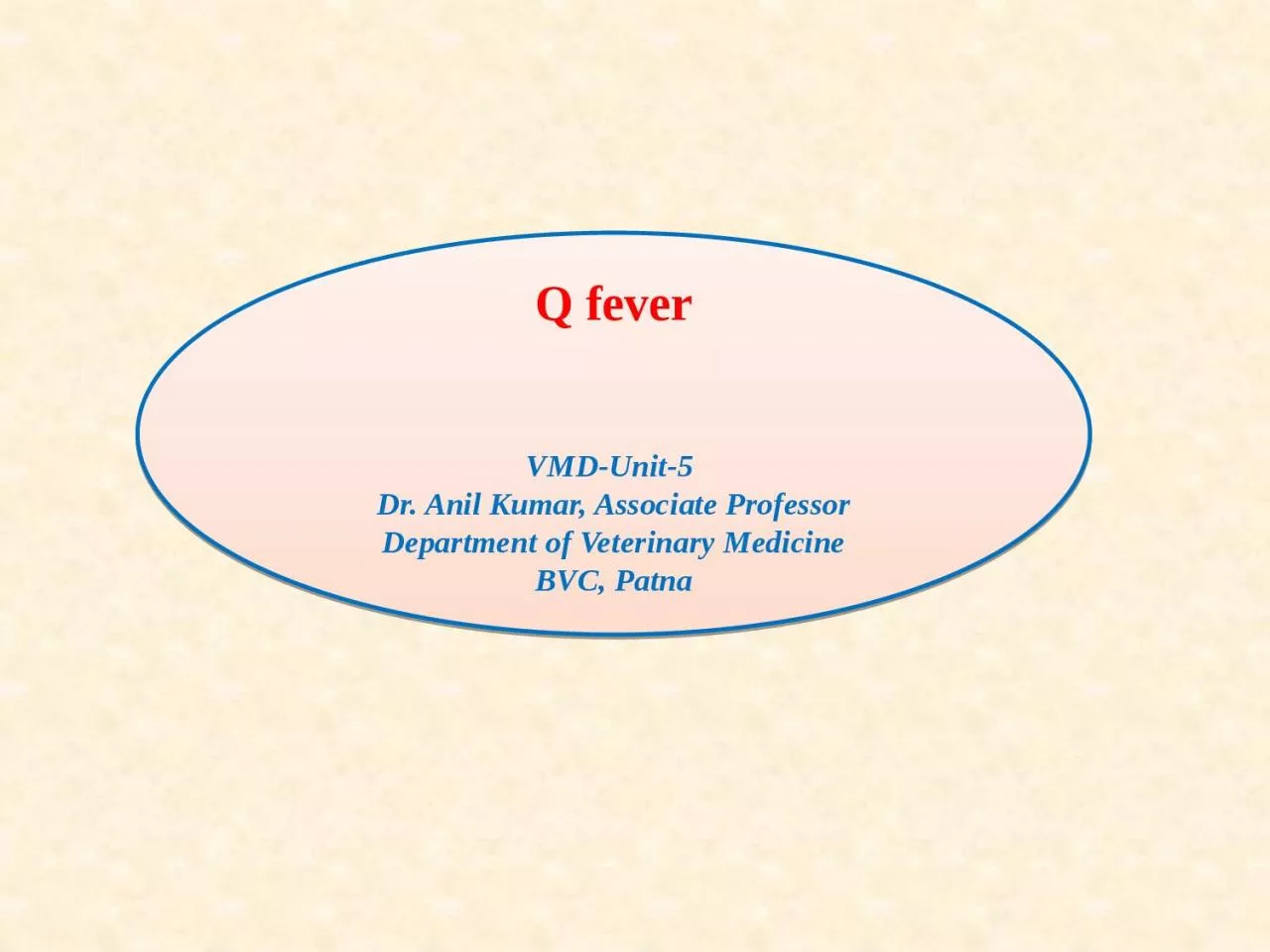

Department of Veterinary Medicine BVC Patna Q fever Introduction Zoonotic febrile disease affecting workers involved in farming livestock D iscovered first in Queensland Australia in 1935 among meat ID: 1012650
Download Presentation The PPT/PDF document "Q fever VMD-Unit-5 Dr. Anil Kumar, Asso..." is the property of its rightful owner. Permission is granted to download and print the materials on this web site for personal, non-commercial use only, and to display it on your personal computer provided you do not modify the materials and that you retain all copyright notices contained in the materials. By downloading content from our website, you accept the terms of this agreement.
1. Q feverVMD-Unit-5 Dr. Anil Kumar, Associate ProfessorDepartment of Veterinary MedicineBVC, Patna
2. Q feverIntroduction:Zoonotic febrile disease affecting workers involved in farming livestockDiscovered first in Queensland, Australia, in 1935 among meat workersEtiology:The causal agent, Coxiella burneti, a Gram-negative, an obligate intracellular bacterium, which displays different morphological forms in its developmental cycleHost affected: Virtually all animal kingdoms, including arthropods (Ticks) But the disease affects mostly humans, cattle, sheep and goatsDomestic ruminants are considered the main reservoirsTransmission:Infection is principally transmitted by inhalation of desiccated aerosol particles ( contaminated fomites)Through exposure in the vicinity of infected animals, their reproductive tissues or other animal products, like wool Ingestion-Ingestion of dairy products prepared from infected milkIn human a very rare chance of transmission from person to person, but exposure during childbirth, through sexual transmission or blood transfusion is possible
3.
4. It is considered a potential agent of bioterrorism because of its low infectious dose, stability in the environment, and ability to be dispersed in aerosol formC burnetii resides and reproduces in the acidified phagolysosomes of host monocytes and macrophages Two forms exist: the large-cell variant (LCV) is a vegetative form found in infected cells; the small-cell variant (SCV) is the extracellular infectious form shed from secretions and excretions (milk, urine, vaginal secretions, semen, and feces) and found in high concentration in placental tissue and amniotic fluidThe small-cell variant (SCV) is resistant to heat, desiccation, and many common disinfectants, and it remains viable for weeks to years in the environment
5. After infecting a domestic ruminant, it localize in mammary glands, supra-mammary lymph nodes, placenta, and uterus, from which it may be shed in subsequent parturitions and lactationsC. burnetii has two antigenic forms: The pathogenic phase I, isolated from infected animals or humans, The attenuated phase II, obtained by repeated in-vitro passages The phase II has been described as a major immunogenic determinant, so used as to detect anti-C. burnetii phase II antibodies in the infective stageIn contrast, vaccination is effective with a phase I vaccine but not with a phase II vaccine
6. Clinical Signs:Ruminants(cows, ewes and goats):It is not recommended to rely on signs for clinical diagnosisIn ruminants, it is usually subclinical formLate abortion and reproductive disorders such as premature birth, dead or weak offspringMetritis and infertility in cattleIn Human: Acute: A self-limiting febrile condition is the most frequent manifestation in clinical cases, which is accompanied by severe headaches, myalgia, arthralgia and a coughPneumonia is another common symptom having dry cough, fever, and minimal respiratory distress
7. Hepatitis with hepatomegaly, but without jaundiceMyocarditis is found in 2% of patients Skin rashes and neurologic disorders such as meningoencephalitisChronic: Endocarditis (aortic and mitral valves)Unspecific signs like intermittent fever, cardiac failure, weakness, fatigue, weight loss or anorexiaOther manifestations like osteomyelitis, osteoarthritis, chronic hepatitis, hepatomegaly, splenomegaly, digital clubbing, purpuric rash and an arterial embolism
8. Diagnosis:Microscopic evaluation of tissue smearsImmunohistochemical testingPCR assayELISA testing (detect antibodies against both phase I and phase II antibodies) Culture of tissue samplesDifferential Diagnosis:Causes of abortion and infertility like leptospirosis, brucellosis, Listeriosis, and salmonellosis. Treatment: In Animals:Two injections of Oxytetracycline (20 mg per kg body weight) in the last trimester of pregnancy are usually recommended for animalsIn Human:
9. Prevention and Control:The inactivated phase I vaccine protects efficiently against abortion and has been shown to prevent bacterial shedding in vaginal mucus, feces, and particularly in milkCoxevac® vaccine (composed of corpuscular antigens) has proven its effectiveness in the prevention of abortions as well as reduction excretion of the germ in goats and cattle Good farming practices Biosecurity, control of animal movement and manure management
10. References:Gebremedhin Y, Shallom M. Review on Q fever in Small Ruminants and its Public Health Importance. Biomed J Sci&Tech Res 9(1)- 2018. BJSTR. MS.ID.001754.DOI: 10.26717/ BJSTR.2018.09.001754Ghaoui H., et al. “Between Livestock’s and Humans, Q Fever Disease is Emerging at Low Noise". Acta Scientific Microbiology 2.10 (2019): 104-132.